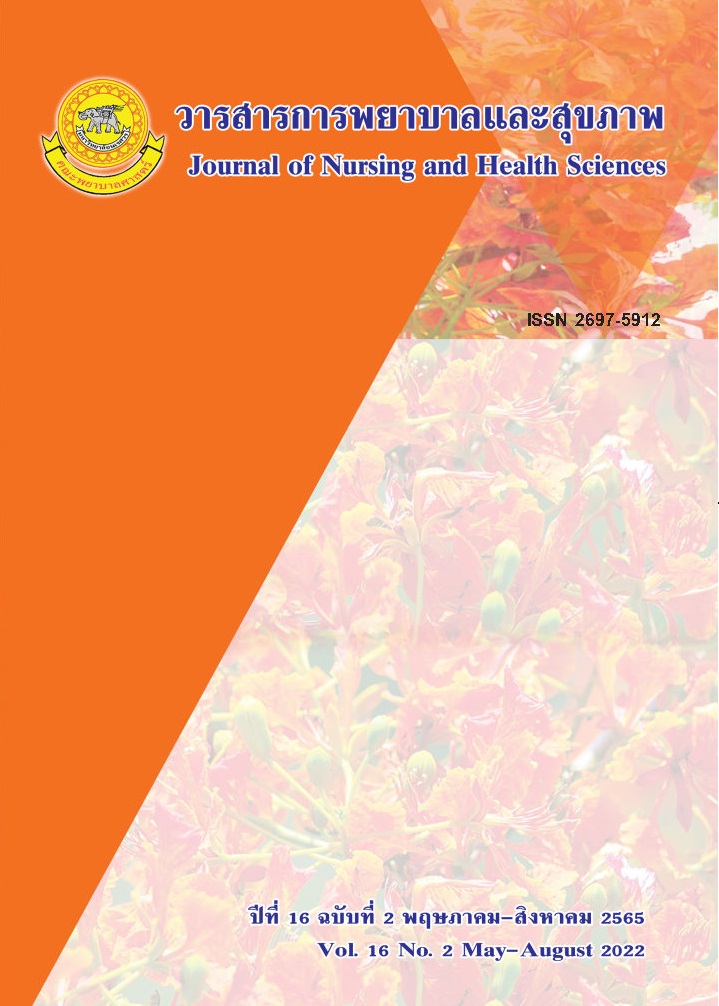คุณสมบัติแบบประเมินผลรวบยอดการสอนแบบสถานการณ์จำลองด้วยหุ่นผู้ป่วยเสมือนจริงสำหรับนักศึกษาพยาบาลฉบับภาษาไทย
Main Article Content
บทคัดย่อ
การวิจัยนี้มีวัตถุประสงค์เพื่อแปลข้ามวัฒนธรรมและทดสอบคุณสมบัติแบบประเมินผลรวบยอดการสอนแบบสถานการณ์จำลองด้วยหุ่นผู้ป่วยเสมือนจริงสำหรับนักศึกษาพยาบาลฉบับภาษาไทย กลุ่มตัวอย่างคือนักศึกษาพยาบาลซึ่งได้รับการเรียนการสอนโดยรูปแบบสถานการณ์จำลองด้วยหุ่นจำลองผู้ป่วยเสมือนจริง จำนวน 109 คน เก็บรวบรวมข้อมูลโดยใช้แบบสอบถามข้อมูลส่วนบุคคลและแบบประเมินผลรวบยอดการสอนแบบสถานการณ์จำลองด้วยหุ่นผู้ป่วยเสมือนจริงสำหรับนักศึกษาพยาบาลฉบับภาษาไทย วิเคราะห์ข้อมูลโดยสถิติพรรณนาและการวิเคราะห์ข้อความ
ผลการศึกษาพบว่า แบบประเมินผลรวบยอดการสอนแบบสถานการณ์จำลองด้วยหุ่นผู้ป่วยเสมือนจริงสำหรับนักศึกษาพยาบาลฉบับภาษาไทยมีความเท่าเทียมด้านเนื้อหาและความเท่าเทียมกันด้านความหมาย ผู้เชี่ยวชาญลงความเห็นว่าแบบประเมินนี้มีความตรงตามเนื้อหาเท่ากับ .78 ค่าดัชนีความตรงตามเนื้อหาของข้อความแต่ละข้อเท่ากับ .80 - 1.00 ค่าดัชนีความตรงตามเนื้อหาของแบบวัดทั้งฉบับเท่ากับ .95 และ ค่าเฉลี่ยของสัดส่วนความสอดคล้องเท่ากับ .95 ผลการวิเคราะห์ข้อความมีค่าความเชื่อมั่นเท่ากับ .913 ค่าสัมประสิทธิ์สหสัมพันธ์ของคะแนนรายข้อกับคะแนนทั้งฉบับอยู่ระหว่าง .305 - .684 ค่าแอลฟาเมื่อตัดข้อความออกอยู่ระหว่าง .907 - .914 ผลการวิจัยแสดงให้เห็นว่า แบบประเมินผลรวบยอดการสอนแบบสถานการณ์จำลองด้วยหุ่นผู้ป่วยเสมือนจริงสำหรับนักศึกษาพยาบาลฉบับภาษาไทย มีความตรงตามเนื้อหาและมีความเชื่อมั่นในระดับสูง ข้อความมีคุณภาพ เป็นข้อความที่ดีสามารถนำไปประเมินผลการจัดการเรียนการสอนโดยสถานการณ์จำลองด้วยหุ่นผู้ป่วยเสมือนจริงทางการพยาบาลได้
Article Details

อนุญาตภายใต้เงื่อนไข Creative Commons Attribution-NonCommercial-NoDerivatives 4.0 International License.
เอกสารอ้างอิง
Chaichanawirote, U.,&Vantum, C. (2017). Evaluation of
content validity for research instrument. Journal
of Nursing and Health Sciences, 11(2). 105-111.
[In Thai].
Cowperthwait, A. (2020). NLN/Jeffries simulation
framework for simulated participant methodology.
Clinical Simulation in Nursing, 42, 12-21.
Foronda, C., Alhusen, J., Budhathoki, C., Lamb, M.,
Tinsley, K., Macwilliams, B., ... Bauman, E.
(2015). A mixed-methods, international, multisite
study to develop and validate a measure of
nurse-to-physician communication in simulation.
Nursing Education Perspectives, 36(6), 383-388.
Jeffries, P. R., Rodgers, B., & Adamson, K. (2015).
NLN Jeffries simulation theory: brief narrative
description. Nursing Education Perspectives,
(5), 292-293.
Jones, P. S., Lee, J. W., Philips, L. R., Zhang, X. E.,
& Jaceldo, K. B. (2001). An adaptation of Brislin’
s translation model for cross-cultural research.
Nursing Research, 50(5), 300-304.
Kadhim, J. J. (2013). Comparing the effectiveness of
debriefing methods in high fidelity simulation in a
nursing baccalaureate program. Master thesis,
Valparaiso University, USA. Retrieved 1 September
from https://scholar.valpo.edu/msn_theses/2/
Kittiteerasack, P., Matthews, A. K., & Steffen, A. (2019).
The validity and linguistic testing of translated
measures of sexual orientation and gender identity
for research in lesbian, gay, bisexual, and
transgender (LGBT) populations in Thailand.
Nursing Journal, 46(4), 122-137. [In Thai].
Krejcie, R. V. & Morgan, D. W. (1970). Determining
sample size for research Activities. Journal of
Educational and Psychological Measurement, 30,
-610.
Kunaviktikul, W. (2015). Teaching and learning in the
discipline of nursing in the 21st century. Nursing
Journal, 42(2), 152-156. [in Thai].
Leighton, K., Mudra, V., & Gilbert, G. E. (2018).
Facilitator Competency Rubric. Retrieved 1
September 2021 from https://studylib.net/doc/
/facilitator-competency-rubric.
Leighton, K., Ravert, P., Mudra, V., & Macintosh, C.
(2015). Update the Simulation Effectiveness
Tool: Item modifications and reevaluation of
psychometricproperties. Nursing Education
Perspectives, 36(5), 317-323.
Nunally, J.C., & Bernstein, I. H. (1994). Psychometric
Theory. New York: McGraw Hill.
Phongphanngam, S., &Lach, H. W. (2019). Cross-cultural
instrumenttranslation and adaptation: Challenges
and strategies. Pacific Rim Int J Nur Res, 23(2),
-179.
Polit, D. F., & Beck, C. T. (2012). Nursing Research:
generating and assessing evidence for nursing
practice (9th ed.). New York: Lippincott Williams
& Wilkins.
Polit, D. F., & Beck, C.T. (2014). Essentials of Nursing
Research: appraising evidence for nursing
practice (8th ed.). New York: Lippincott Williams
& Wilkins.
Spector, P. E. (1992). Summated Rating Scale Construction:
An Introduction. Newbury Park, CL: SAGE
publications.
Reising, D. L., Carr, D. E., Tieman, S., Feather, R. &
Ozdogan, Z. (2015). Psychometric testing of a
simulation rubric for measuring interprofessional
communication. Nursing Education Perspective,
(5), 311-316.
Schmidt, N., & Brown, J. M. (personal communication,
January, 12, 2021). Comprehensive Simulation
Evaluation Survey. College of Nursing and Health
Profession, Valparaiso University. USA.
Srisatidnarakul, B. (2014). Translation of nursing
research instrument in foreign language and
Psychometric property testing. Journal of
Research and Curriculum Development, 4(2),
-61. [In Thai].
Tiansawad, S. (2019). Instrument development for
nursing research. Chiang Mai: Siampimnana.
[In Thai].
Unjai, S., &Somjaivong, B. (2016). Translation and
reliability of the supportive care need survey Thai
version in cervical cancer patients. Journal of
Nursing Sciences & Health, 39(3), 119-126.
[In Thai].
Wongsutin, R., Meeboon, S., Sukolpuk, M., Teerawongsa,
N., Sirisabjanan,L., & Tojun, S. (2019). Nursing
students' perceptions on high-fidelity simulation
learning and learning outcomes regarding
Thailand qualification framework. Journal of
Health Science Research, 13(2), 11-19. [In Thai].


